How Mask Designers Engineers Won
The 67th International Astronautical Congress expectedly brought a sensation - Ilon Musk made plans for the colonization of Mars. Beautiful video, excellent presentation in the style of Apple, however, left a bewildering perplexity. Without plunging into formulas, it’s just “on the fingers” that the proposed technical solutions and device characteristics are very strange.

The very first frames already cause bewilderment. The service tower on the left is smoothly finished and no technical devices stick out of it. Real service towers in the warm climate of the United States look like this:
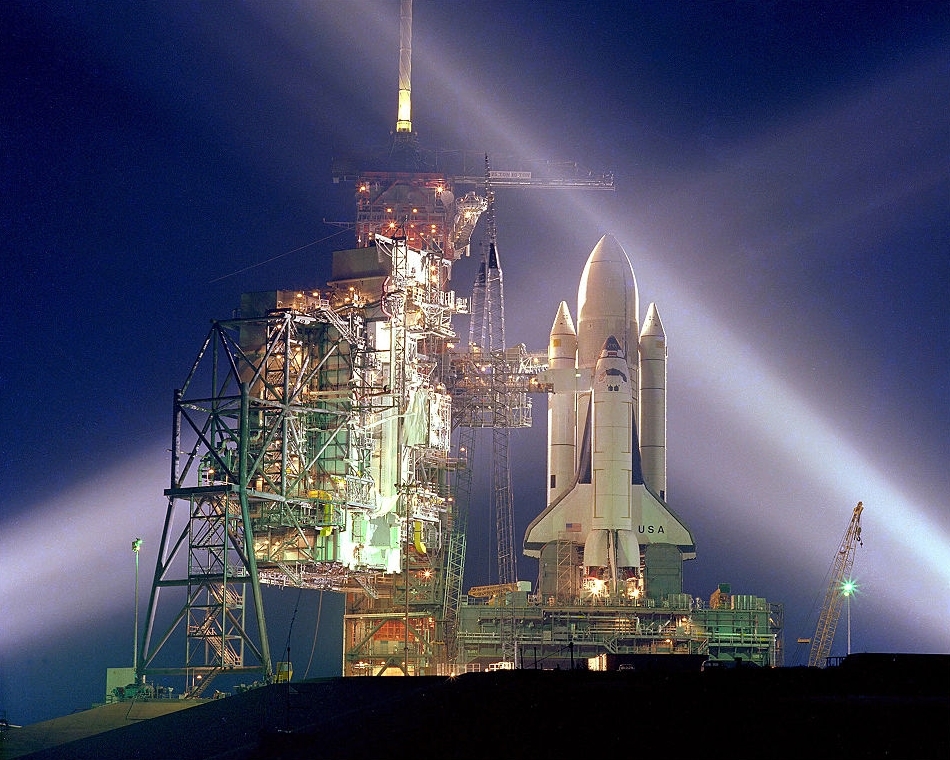
You will say that this is a trifle, and you will be right - indeed, you can draw any tower. The problem is that instead of drawing true, the SpaceX artists decided to paint beautifully. The maintenance tower is a utilitarian technical device. It can be made beautiful, smooth and shiny, but it will require additional money, and it will not work better. How will such expenses be combined with an affordable Mars ticket?

The spacecraft of the 21st century is reminiscent of rockets in proportions and number of windows as they were drawn in the 50s.

Rocket Flush Gordon. We have this character is not very well known, but how many Americans are choking at the monitor?
In reality, engineers more often spent their talents on making windows less - multi-layered glass (able to withstand vacuum and micrometeorites) weighs a lot. Here, for example, is a visual history of how they fought with portholes in the American lunar module.
The series From the Earth to the Moon, from where the video was taken, is strongly recommended for viewing.
And if you remembered the Cupola module on the ISS, it appeared only ten years after the station began to work, before that it was managed with individual portholes. And in it the portholes are closed with flaps.

In addition to weight, large glass structures will also be expensive. So, say cheap Mars tickets?

Beautiful strict rocket lines and service towers. No retractable masts, as was the case in reality.
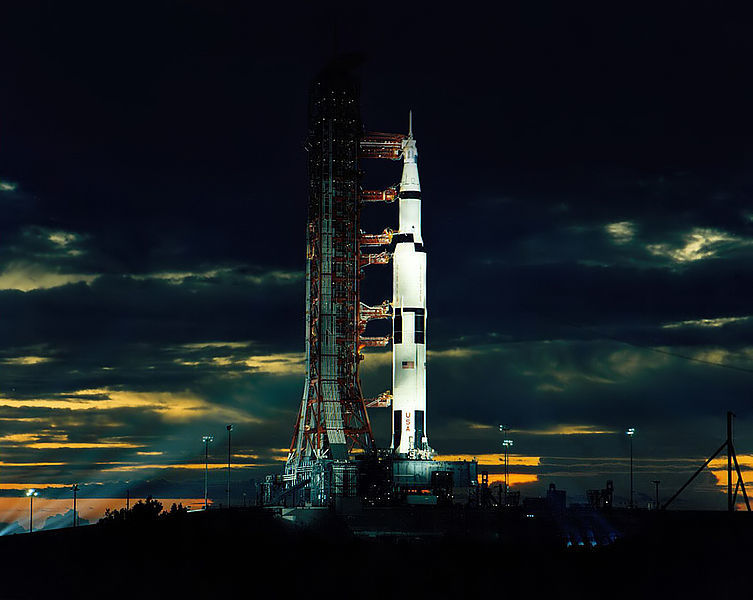
No, of course, it is technically possible to make such a construction. For example, on the Proton cables go to a special contact pad between the engines.

If you wish, you can refuel both steps from the bottom by stretching the pipelines of the second stage through the first one, but why?

The forty-two first-stage engines will become an obvious target for criticism due to reliability issues. But in reality, the relationship of reliability and the number of engines is somewhat more complicated . If the rocket has a reserve of thrust-carrying capacity, and the accident will not lead to damage to neighboring engines, then the loss of one can be overcome.
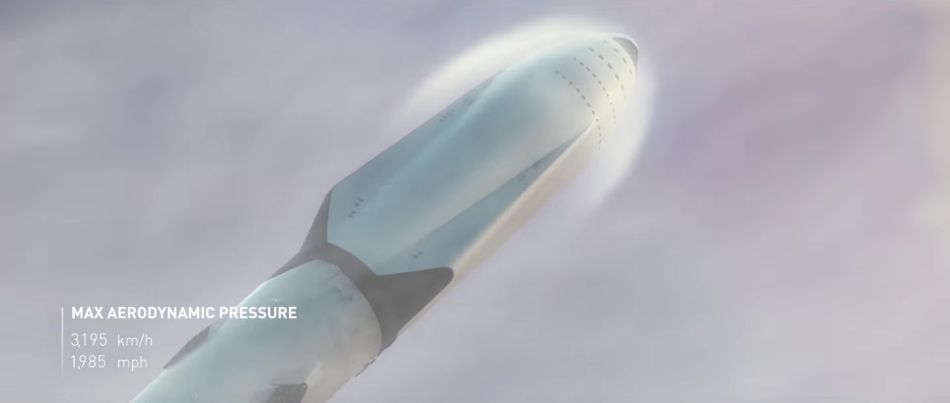
There are no signs of the rescue system on the ship. In principle, it is logical for a flight to Mars in one direction, and for hundreds of crew members it will be completely inadequately expensive and difficult, but the crash at the start will be very offensive.

One of the strangest shots. First, the return to the place of launch is a great loss of the payload.. No one bothers to sit down further along the path and not waste precious tons of fuel to return. Secondly, why bother to sit in your own starting table? Landing requires virtually centimeter accuracy, even with active starting pick-up units, which is difficult to imagine for such a large rocket. And any serious accident will lead to the fact that the rocket will fall at the start and bring it down. Against the backdrop of a recent accident with the destruction of the launch pad, this solution looks especially strange. Saving time to transport the first stage? But this saving on matches - the disadvantages clearly outweigh.

The idea of refueling in orbit is quite sensible. The only question is what to refuel. According to the SpaceX presentation on the ship, there are Raptor engines operating on supercooled methane and oxygen. This means that all the time of the flight to Mars, the components of the fuel will be stored in the tanks for landing. And without heat insulation tanks they heat up and evaporate. That is why real spacecraft in deep space take heptyl and amyl stored in liquid form at room temperature. And cryogenic steps live in orbit at best for hours. Yes, tanks can technically be insulated, but it will be a huge loss of weight and money. For example, in the RSC Energia Museum, there are tanks for Buran, in which liquid oxygen could be stored for weeks.

The real tank is small and the walls are thick. A large tank drawn ship will have a huge surface and a corresponding number of different technological holes. Thermal insulation will make it literally gold in both weight and cost.

Beautiful, but here designers have won engineers. Without a turning point, solar panels will require a bow / stern turn toward the Sun of the ship itself, which is inconvenient and requires additional fuel consumption. In the video, by the way, the ship ignores the direction of the sun in general.
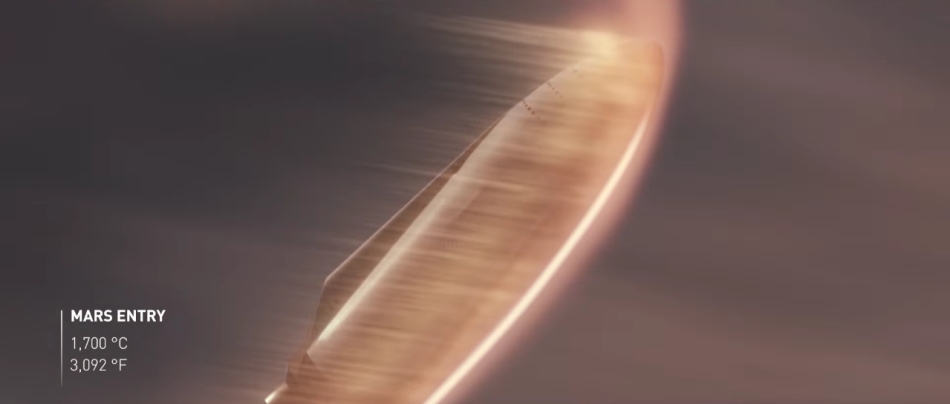
It turns out that we dragged reusable heat protection in the style of a shuttle to Mars and braked it along with rudimentary wings. It is sad that the designers Mask ignored the elaborated engineering ideas, how to slow down in the atmosphere of Mars, and painted the landing for the thick atmosphere of the Earth. This is how a much more realistic fit looks like.
The fact is that Mars has a very thin atmosphere, and the average pressure on the surface is around half a cent of the earth. It is inconvenient to use it for braking, and it is impossible not to take it into account either. You can try it yourself ( option one , option two ), how uncomfortable it is.

Poor aerodynamics. By the way, the speed of a meeting with Mars will even be 5-6 km / s at best, i.e. the ship will have to carry fuel to change the characteristic speed (delta-V) at least six kilometers. According to the simple schemewe need 4.2 km / s to fly to Mars, and about five to slow down. Braking in such a way as on the video, will allow to reduce the speed of the atmosphere for free, estimating on the fingers, about two kilometers, and the rest will have to be extinguished by engines, wasting fuel. Such a large supply of characteristic speed for one stage is not very common, but technically possible.
The design of the ship says that it should be used as a reusable vehicle between Earth and Mars. Moreover, it will have to take off from Mars and accelerate to the Earth, using only one degree. Physics does not prohibit this, but the solution looks irrational, the required total time of the engines will be very large, and their accident will lead to the impossibility of further phases of flight.
After watching this video, the ship “Hermes” from fiction “The Martian” begins to seem to be a fully developed project - in fact, it can turn solar panels, have heat exchange system radiators, a reactor and an efficient engine, and a quite adequate number of people in the crew.
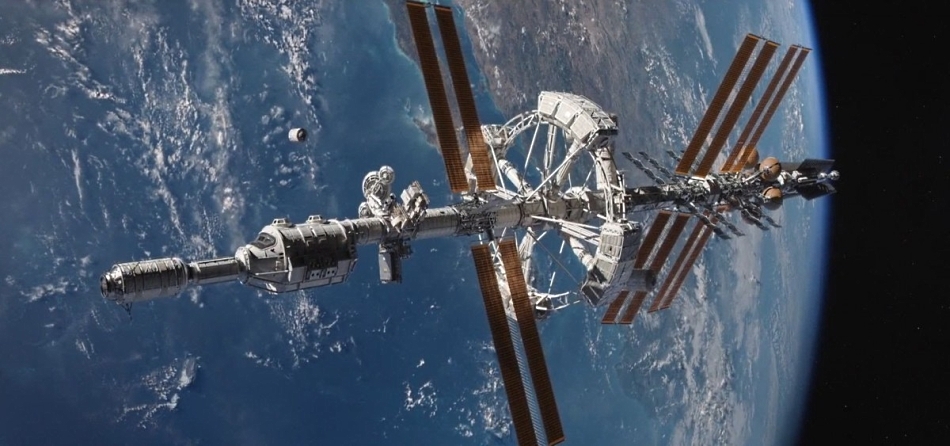
Presentation materials also raise questions.

Here, in principle, the pitfalls are ignored , which can make the comparison with the liner absolutely incorrect.
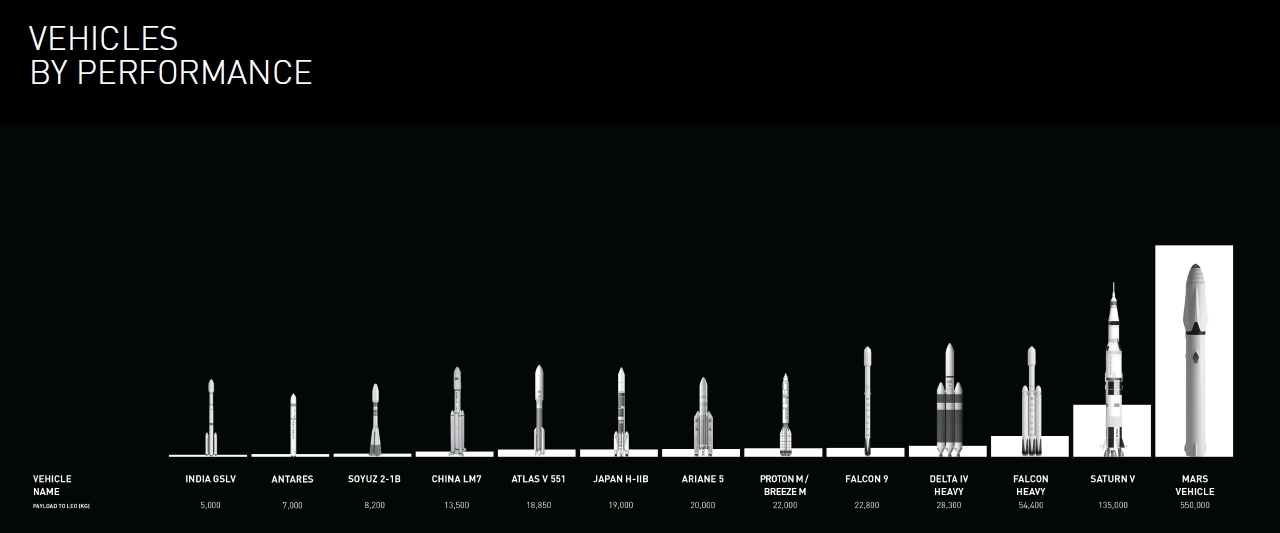
In simple terms, SpaceX is going to build a huge mining truck. Suppose it is suitable for Mars. But for what tasks in near-earth orbit, on which only while you can earn, will you need a rocket for 300/550 tons of payload? The Falcon 9 / Heavy family can at least make money on version 9 and send a small load to Mars in the Heavy version, why build a new monster?
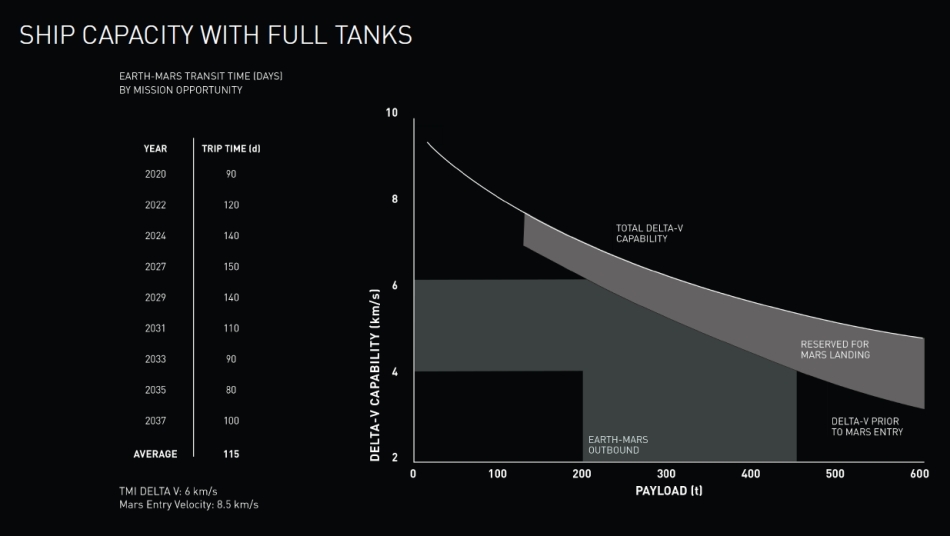
Do you know why now interplanetary stations fly to Mars for half a year instead of 115 days on average? It's very simple - the faster we want to fly, the more we need to spend fuel on it.
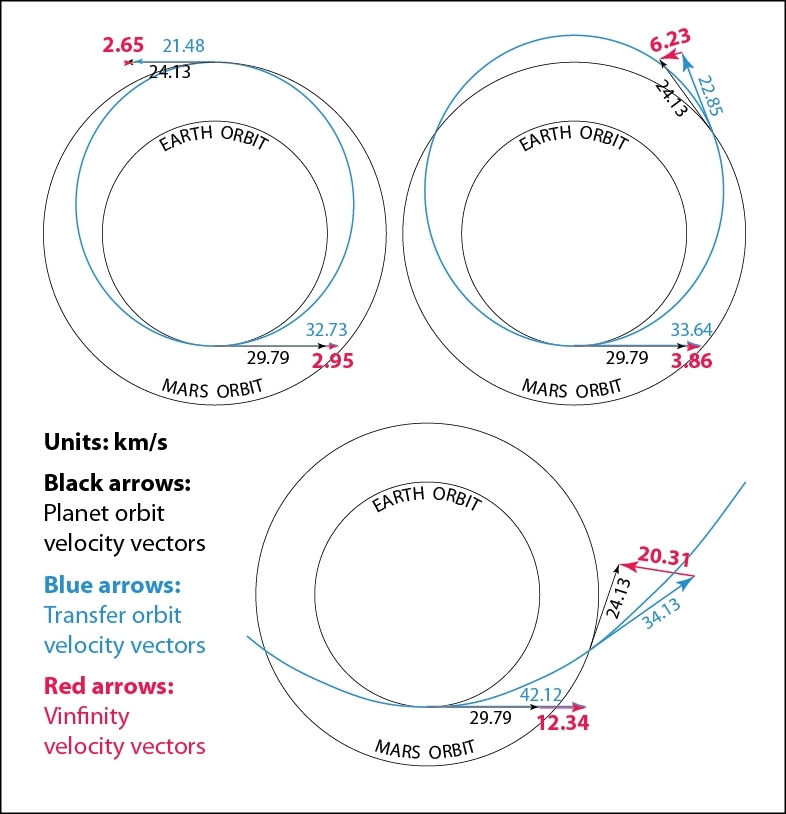
The most economical option is on the top left. Gomanov transition. Do you want faster - pay by the fact that instead of the payload you will have fuel. And now the question - how fast and expensive flight will be combined with an affordable ticket to Mars?

Excellent business plan. Reusable rockets Mask and your amateur - that's all that is needed for success. The “ordinary” manned mission to Mars is estimated at a hundred billion dollars, and the money for thousands of ships with colonists will only give the Mask to the World Council after the victory of communism on the entire planet.
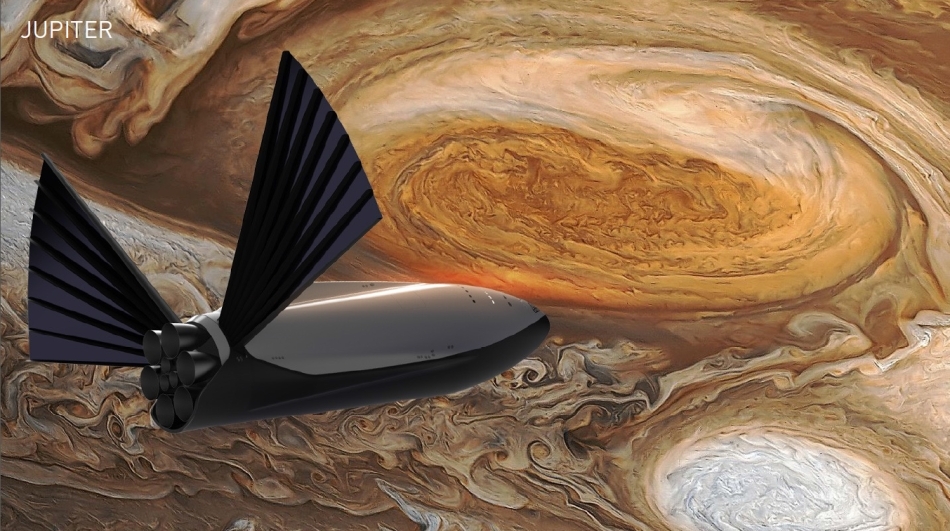
After Jupiter’s orbit, the first ever Jupiter-New Vasyuki chess match will take place. And the presentation also talked about interstellar flights ...
The presentation of the Mask showed a monstrous, controversial, poorly designed and causing a huge number of questions the project. Which, however, was enthusiastically received by the public and became a sensation. The latest news - hundreds of people write to SpaceX, wanting to fly to Mars, obviously believing in the possibility and availability of such a flight. But are such dreams real? Cosmonautics pioneers dreamed of space, but their dreams were supported by mathematical calculations about the basic possibility of flying, and the first engines that were obtained reinforced confidence in the reality of success .. The dreams came true, albeit in a different form - robots are now working on Mars, and astronautics have real benefits. Dreaming deliberately about the unrealizable, believing that the desired will be achieved in some magical way, despite the boring mathematics, physics and economics - this is the level of MLM and the film “The Secret”. Now, in the postmodern world, public relations can be more important than real work, but one cannot do without it at all. And it's far from a fact that the magnetism of the “Forward to Mars” idea will increase SpaceX's competitiveness on the market - enthusiasts usually have little money, but businessmen can count them, and no beauty of Mars will force them to buy space on a rocket if it keeps statistics on one accident for ten flights. For a qualitative leap into space, new technologies are needed, which are not yet visible. A slow and gradual path of development of astronautics looks less impressive. In the presentation, Musk showed a beautiful dream that will be extremely difficult to accomplish even in a truncated version. And it remains only to hope that this will not lead to yet another disillusionment in the space program. but one cannot do without it at all. And it's far from a fact that the magnetism of the “Forward to Mars” idea will increase SpaceX's competitiveness on the market - enthusiasts usually have little money, but businessmen can count them, and no beauty of Mars will force them to buy space on a rocket if it keeps statistics on one accident for ten flights. For a qualitative leap into space, new technologies are needed, which are not yet visible. A slow and gradual path of development of astronautics looks less impressive. In the presentation, Musk showed a beautiful dream that will be extremely difficult to accomplish even in a truncated version. And it remains only to hope that this will not lead to yet another disillusionment in the space program. but one cannot do without it at all. And it's far from a fact that the magnetism of the “Forward to Mars” idea will increase SpaceX's competitiveness on the market - enthusiasts usually have little money, but businessmen can count them, and no beauty of Mars will force them to buy space on a rocket if it keeps statistics on one accident for ten flights. For a qualitative leap into space, new technologies are needed, which are not yet visible. A slow and gradual path of development of astronautics looks less impressive. In the presentation, Musk showed a beautiful dream that will be extremely difficult to accomplish even in a truncated version. And it remains only to hope that this will not lead to yet another disillusionment in the space program. to Mars ”will increase SpaceX’s competitiveness on the market - enthusiasts usually have little money, but businessmen can count them, and no beauty of Mars will force them to buy space on a rocket if it keeps statistics with one accident per ten flights. For a qualitative leap into space, new technologies are needed, which are not yet visible. A slow and gradual path of development of astronautics looks less impressive. In the presentation, Musk showed a beautiful dream that will be extremely difficult to accomplish even in a truncated version. And it remains only to hope that this will not lead to yet another disillusionment in the space program. to Mars ”will increase SpaceX’s competitiveness on the market - enthusiasts usually have little money, but businessmen can count them, and no beauty of Mars will force them to buy space on a rocket if it keeps statistics with one accident per ten flights. For a qualitative leap into space, new technologies are needed, which are not yet visible. A slow and gradual path of development of astronautics looks less impressive. In the presentation, Musk showed a beautiful dream that will be extremely difficult to accomplish even in a truncated version. And it remains only to hope that this will not lead to yet another disillusionment in the space program. which is not yet visible. A slow and gradual path of development of astronautics looks less impressive. In the presentation, Musk showed a beautiful dream that will be extremely difficult to accomplish even in a truncated version. And it remains only to hope that this will not lead to yet another disillusionment in the space program. which is not yet visible. A slow and gradual path of development of astronautics looks less impressive. In the presentation, Musk showed a beautiful dream that will be extremely difficult to accomplish even in a truncated version. And it remains only to hope that this will not lead to yet another disillusionment in the space program.

The very first frames already cause bewilderment. The service tower on the left is smoothly finished and no technical devices stick out of it. Real service towers in the warm climate of the United States look like this:

You will say that this is a trifle, and you will be right - indeed, you can draw any tower. The problem is that instead of drawing true, the SpaceX artists decided to paint beautifully. The maintenance tower is a utilitarian technical device. It can be made beautiful, smooth and shiny, but it will require additional money, and it will not work better. How will such expenses be combined with an affordable Mars ticket?

The spacecraft of the 21st century is reminiscent of rockets in proportions and number of windows as they were drawn in the 50s.

Rocket Flush Gordon. We have this character is not very well known, but how many Americans are choking at the monitor?
In reality, engineers more often spent their talents on making windows less - multi-layered glass (able to withstand vacuum and micrometeorites) weighs a lot. Here, for example, is a visual history of how they fought with portholes in the American lunar module.
The series From the Earth to the Moon, from where the video was taken, is strongly recommended for viewing.
And if you remembered the Cupola module on the ISS, it appeared only ten years after the station began to work, before that it was managed with individual portholes. And in it the portholes are closed with flaps.

In addition to weight, large glass structures will also be expensive. So, say cheap Mars tickets?

Beautiful strict rocket lines and service towers. No retractable masts, as was the case in reality.

No, of course, it is technically possible to make such a construction. For example, on the Proton cables go to a special contact pad between the engines.

If you wish, you can refuel both steps from the bottom by stretching the pipelines of the second stage through the first one, but why?

The forty-two first-stage engines will become an obvious target for criticism due to reliability issues. But in reality, the relationship of reliability and the number of engines is somewhat more complicated . If the rocket has a reserve of thrust-carrying capacity, and the accident will not lead to damage to neighboring engines, then the loss of one can be overcome.

There are no signs of the rescue system on the ship. In principle, it is logical for a flight to Mars in one direction, and for hundreds of crew members it will be completely inadequately expensive and difficult, but the crash at the start will be very offensive.

One of the strangest shots. First, the return to the place of launch is a great loss of the payload.. No one bothers to sit down further along the path and not waste precious tons of fuel to return. Secondly, why bother to sit in your own starting table? Landing requires virtually centimeter accuracy, even with active starting pick-up units, which is difficult to imagine for such a large rocket. And any serious accident will lead to the fact that the rocket will fall at the start and bring it down. Against the backdrop of a recent accident with the destruction of the launch pad, this solution looks especially strange. Saving time to transport the first stage? But this saving on matches - the disadvantages clearly outweigh.

The idea of refueling in orbit is quite sensible. The only question is what to refuel. According to the SpaceX presentation on the ship, there are Raptor engines operating on supercooled methane and oxygen. This means that all the time of the flight to Mars, the components of the fuel will be stored in the tanks for landing. And without heat insulation tanks they heat up and evaporate. That is why real spacecraft in deep space take heptyl and amyl stored in liquid form at room temperature. And cryogenic steps live in orbit at best for hours. Yes, tanks can technically be insulated, but it will be a huge loss of weight and money. For example, in the RSC Energia Museum, there are tanks for Buran, in which liquid oxygen could be stored for weeks.

The real tank is small and the walls are thick. A large tank drawn ship will have a huge surface and a corresponding number of different technological holes. Thermal insulation will make it literally gold in both weight and cost.

Beautiful, but here designers have won engineers. Without a turning point, solar panels will require a bow / stern turn toward the Sun of the ship itself, which is inconvenient and requires additional fuel consumption. In the video, by the way, the ship ignores the direction of the sun in general.

It turns out that we dragged reusable heat protection in the style of a shuttle to Mars and braked it along with rudimentary wings. It is sad that the designers Mask ignored the elaborated engineering ideas, how to slow down in the atmosphere of Mars, and painted the landing for the thick atmosphere of the Earth. This is how a much more realistic fit looks like.
The fact is that Mars has a very thin atmosphere, and the average pressure on the surface is around half a cent of the earth. It is inconvenient to use it for braking, and it is impossible not to take it into account either. You can try it yourself ( option one , option two ), how uncomfortable it is.

Poor aerodynamics. By the way, the speed of a meeting with Mars will even be 5-6 km / s at best, i.e. the ship will have to carry fuel to change the characteristic speed (delta-V) at least six kilometers. According to the simple schemewe need 4.2 km / s to fly to Mars, and about five to slow down. Braking in such a way as on the video, will allow to reduce the speed of the atmosphere for free, estimating on the fingers, about two kilometers, and the rest will have to be extinguished by engines, wasting fuel. Such a large supply of characteristic speed for one stage is not very common, but technically possible.
The design of the ship says that it should be used as a reusable vehicle between Earth and Mars. Moreover, it will have to take off from Mars and accelerate to the Earth, using only one degree. Physics does not prohibit this, but the solution looks irrational, the required total time of the engines will be very large, and their accident will lead to the impossibility of further phases of flight.
After watching this video, the ship “Hermes” from fiction “The Martian” begins to seem to be a fully developed project - in fact, it can turn solar panels, have heat exchange system radiators, a reactor and an efficient engine, and a quite adequate number of people in the crew.

Presentation
Presentation materials also raise questions.

Here, in principle, the pitfalls are ignored , which can make the comparison with the liner absolutely incorrect.

In simple terms, SpaceX is going to build a huge mining truck. Suppose it is suitable for Mars. But for what tasks in near-earth orbit, on which only while you can earn, will you need a rocket for 300/550 tons of payload? The Falcon 9 / Heavy family can at least make money on version 9 and send a small load to Mars in the Heavy version, why build a new monster?

Do you know why now interplanetary stations fly to Mars for half a year instead of 115 days on average? It's very simple - the faster we want to fly, the more we need to spend fuel on it.

The most economical option is on the top left. Gomanov transition. Do you want faster - pay by the fact that instead of the payload you will have fuel. And now the question - how fast and expensive flight will be combined with an affordable ticket to Mars?

Excellent business plan. Reusable rockets Mask and your amateur - that's all that is needed for success. The “ordinary” manned mission to Mars is estimated at a hundred billion dollars, and the money for thousands of ships with colonists will only give the Mask to the World Council after the victory of communism on the entire planet.

After Jupiter’s orbit, the first ever Jupiter-New Vasyuki chess match will take place. And the presentation also talked about interstellar flights ...
About dreams and reality
The presentation of the Mask showed a monstrous, controversial, poorly designed and causing a huge number of questions the project. Which, however, was enthusiastically received by the public and became a sensation. The latest news - hundreds of people write to SpaceX, wanting to fly to Mars, obviously believing in the possibility and availability of such a flight. But are such dreams real? Cosmonautics pioneers dreamed of space, but their dreams were supported by mathematical calculations about the basic possibility of flying, and the first engines that were obtained reinforced confidence in the reality of success .. The dreams came true, albeit in a different form - robots are now working on Mars, and astronautics have real benefits. Dreaming deliberately about the unrealizable, believing that the desired will be achieved in some magical way, despite the boring mathematics, physics and economics - this is the level of MLM and the film “The Secret”. Now, in the postmodern world, public relations can be more important than real work, but one cannot do without it at all. And it's far from a fact that the magnetism of the “Forward to Mars” idea will increase SpaceX's competitiveness on the market - enthusiasts usually have little money, but businessmen can count them, and no beauty of Mars will force them to buy space on a rocket if it keeps statistics on one accident for ten flights. For a qualitative leap into space, new technologies are needed, which are not yet visible. A slow and gradual path of development of astronautics looks less impressive. In the presentation, Musk showed a beautiful dream that will be extremely difficult to accomplish even in a truncated version. And it remains only to hope that this will not lead to yet another disillusionment in the space program. but one cannot do without it at all. And it's far from a fact that the magnetism of the “Forward to Mars” idea will increase SpaceX's competitiveness on the market - enthusiasts usually have little money, but businessmen can count them, and no beauty of Mars will force them to buy space on a rocket if it keeps statistics on one accident for ten flights. For a qualitative leap into space, new technologies are needed, which are not yet visible. A slow and gradual path of development of astronautics looks less impressive. In the presentation, Musk showed a beautiful dream that will be extremely difficult to accomplish even in a truncated version. And it remains only to hope that this will not lead to yet another disillusionment in the space program. but one cannot do without it at all. And it's far from a fact that the magnetism of the “Forward to Mars” idea will increase SpaceX's competitiveness on the market - enthusiasts usually have little money, but businessmen can count them, and no beauty of Mars will force them to buy space on a rocket if it keeps statistics on one accident for ten flights. For a qualitative leap into space, new technologies are needed, which are not yet visible. A slow and gradual path of development of astronautics looks less impressive. In the presentation, Musk showed a beautiful dream that will be extremely difficult to accomplish even in a truncated version. And it remains only to hope that this will not lead to yet another disillusionment in the space program. to Mars ”will increase SpaceX’s competitiveness on the market - enthusiasts usually have little money, but businessmen can count them, and no beauty of Mars will force them to buy space on a rocket if it keeps statistics with one accident per ten flights. For a qualitative leap into space, new technologies are needed, which are not yet visible. A slow and gradual path of development of astronautics looks less impressive. In the presentation, Musk showed a beautiful dream that will be extremely difficult to accomplish even in a truncated version. And it remains only to hope that this will not lead to yet another disillusionment in the space program. to Mars ”will increase SpaceX’s competitiveness on the market - enthusiasts usually have little money, but businessmen can count them, and no beauty of Mars will force them to buy space on a rocket if it keeps statistics with one accident per ten flights. For a qualitative leap into space, new technologies are needed, which are not yet visible. A slow and gradual path of development of astronautics looks less impressive. In the presentation, Musk showed a beautiful dream that will be extremely difficult to accomplish even in a truncated version. And it remains only to hope that this will not lead to yet another disillusionment in the space program. which is not yet visible. A slow and gradual path of development of astronautics looks less impressive. In the presentation, Musk showed a beautiful dream that will be extremely difficult to accomplish even in a truncated version. And it remains only to hope that this will not lead to yet another disillusionment in the space program. which is not yet visible. A slow and gradual path of development of astronautics looks less impressive. In the presentation, Musk showed a beautiful dream that will be extremely difficult to accomplish even in a truncated version. And it remains only to hope that this will not lead to yet another disillusionment in the space program.
